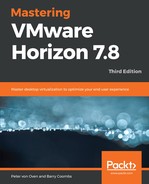Starting at a high level, a clone is a copy of an existing or parent virtual machine. This parent virtual desktop machine is your gold build from which you want to create new virtual desktop machines. When a clone is created, it becomes a separate, new virtual desktop machine with its own unique identity. This process is not unique to Horizon View. It's actually a function of vSphere and vCenter, and in the case of Horizon View, we add in another component, View Composer, to manage the desktop images. There are three types of clone that can be deployed: a full clone, a linked clone, or an instant clone.
One of the main reasons a virtual desktop project fails to deliver or doesn't even get out of the starting blocks is because of the heavy infrastructure and storage requirements. The storage requirements are often seen as a huge cost burden, which can be attributed to the fact that people are approaching a VDI project in the same way they would approach a physical desktop environment. This would mean that each user gets their own dedicated virtual desktop and the hard-disk space that comes with it, albeit a virtual disk. This is then scaled out for the entire user population, with each user being allocated a virtual desktop with some storage.
Let's discuss an example. If you had 1,000 users and allocated 250 GB disk space per desktop, you would need 1,000 * 250 GB = 250 TB of disk space just for the virtual desktop environment. That's a lot of storage just for desktops and could result in significant infrastructure costs, which could possibly mean that the cost to deploy this amount of storage in the data center would render the project cost-ineffective compared to physical desktop deployments. This would be described as the Full Clone approach.
